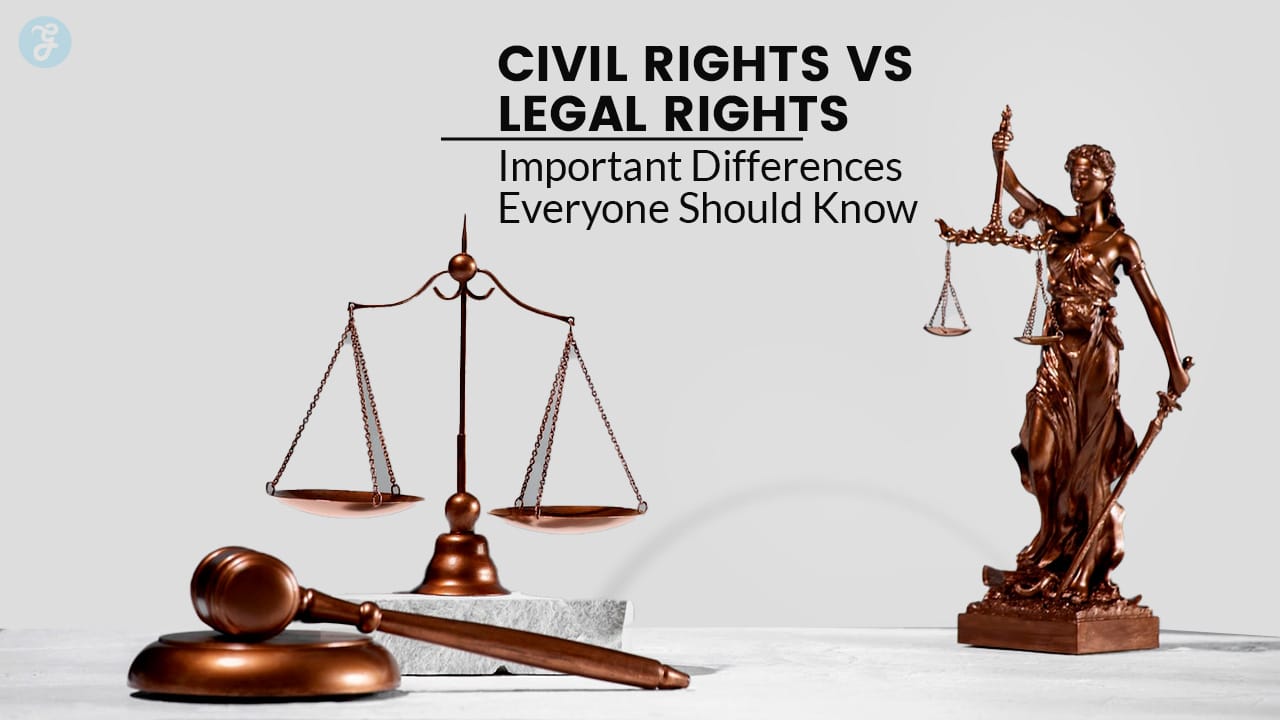Understanding the distinction between civil rights and legal rights is more than just a matter of terminology—it’s a crucial aspect of safeguarding your freedoms and responsibilities in a complex legal framework. Civil rights and legal rights are often confused, but each plays a distinct role in shaping how we live, work, and interact with others. Civil rights protect individuals from discrimination and ensure equality in areas like voting, speech, and religious practices. Legal rights, on the other hand, provide the framework for specific legal entitlements, such as property ownership, contract enforcement, and taxation.
This article will guide you through the nuances of these two types of rights, exploring their origins, applications, and why understanding civil rights vs. legal rights is indispensable for navigating today’s legal and societal challenges. Whether you’re a student, professional, or concerned citizen, this comprehensive guide will help you make informed decisions and stand up for what’s right.
What Are Civil Rights?
Civil rights are the fundamental rights and freedoms guaranteed to individuals by law to ensure equality and protect against discrimination. These rights are often rooted in constitutional principles and are designed to safeguard individuals from unfair treatment based on race, gender, religion, or other characteristics.
Key Features of Civil Rights:
- Purpose: To promote equality and freedom for all individuals.
- Examples:
- The right to vote.
- Freedom of speech and expression.
- Protection against racial or gender discrimination.
- Foundation: These rights are often enshrined in national constitutions or international treaties.
Overview of Civil Rights
| Feature | Description |
| Purpose | Ensure equality and prevent discrimination. |
| Key Examples | Voting rights, free speech, anti-discrimination |
| Legal Basis | Constitutional and legislative frameworks |
| Enforced By | Government agencies and courts |
Additional Insights
Civil rights often form the backbone of democratic societies. They ensure that minority groups and marginalized populations have equal opportunities. Landmark movements such as the Civil Rights Movement in the United States highlight the struggle and progress made in achieving these rights.
What Are Legal Rights?
Legal rights are specific rights granted to individuals by laws enacted by governing bodies. These rights are often tied to legal systems and can vary by jurisdiction. Unlike civil rights, which are universal in nature, legal rights are often situation-specific and may be revised as laws evolve.
Key Features of Legal Rights:
- Purpose: To provide specific protections or obligations under the law.
- Examples:
- Property ownership rights.
- Rights outlined in employment contracts.
- Tax-related rights and obligations.
- Foundation: Established through legislative processes.
Overview of Legal Rights
| Feature | Description |
| Purpose | Define specific protections and obligations. |
| Key Examples | Property rights, contractual rights, tax laws |
| Legal Basis | Statutory or case law |
| Enforced By | Local or national courts |
Additional Insights
Legal rights are dynamic and vary significantly across jurisdictions. For instance, property rights in one country may differ vastly from those in another. It is crucial for individuals to understand the laws applicable in their region.
Historical Context of Civil and Legal Rights
Both civil and legal rights have evolved to address societal needs. Milestones like the Civil Rights Act of 1964 and the introduction of property laws illustrate the importance of distinguishing civil rights vs. legal rights in understanding societal progress.
Milestones in Civil Rights:
- The Civil Rights Act of 1964 (USA): Ended segregation and employment discrimination.
- Universal Declaration of Human Rights (1948): Set global standards for civil liberties.
Milestones in Legal Rights:
- Introduction of property laws: Protected ownership rights.
- Development of labor laws: Ensured fair treatment of workers.
Key Historical Events
| Event | Year | Significance |
| Civil Rights Act | 1964 | Ended segregation in the USA |
| Universal Declaration | 1948 | Established global human rights standards |
| Property Laws | Various | Defined ownership rights globally |
| Labor Laws | Various | Protected workers’ rights |
Additional Insights
Understanding the historical context of these rights underscores their importance. For example, the Civil Rights Movement’s impact on modern-day equality highlights how these rights evolve to meet societal demands.
Civil Rights vs. Legal Rights: Core Differences
Here are the nine critical differences between civil rights and legal rights:
1. Nature
- Civil Rights: Focus on equality and freedom.
- Legal Rights: Govern specific legal interactions and obligations.
2. Origin
- Civil Rights: Stem from constitutional or universal principles.
- Legal Rights: Arise from statutes or case law.
3. Scope
- Civil Rights: Broader and often fundamental.
- Legal Rights: Narrow and specific.
4. Protection
- Civil Rights: Protect against societal discrimination.
- Legal Rights: Regulate interactions between individuals and entities.
5. Universality
- Civil Rights: Often universal.
- Legal Rights: Jurisdiction-specific.
6. Changeability
- Civil Rights: Require constitutional amendments to change.
- Legal Rights: Can be amended through legislative processes.
7. Enforcement
- Civil Rights: Enforced by federal or international bodies.
- Legal Rights: Enforced by local courts.
8. Focus
- Civil Rights: Emphasize societal equality.
- Legal Rights: Address individual or contractual obligations.
9. Examples
- Civil Rights: Voting, freedom of speech.
- Legal Rights: Property, contractual rights.
Civil Rights vs. Legal Rights
| Aspect | Civil Rights | Legal Rights |
| Nature | Equality and freedom | Legal interactions and obligations |
| Origin | Constitutional principles | Statutes or case law |
| Scope | Broad and universal | Narrow and specific |
| Enforcement | Federal bodies or courts | Local or national courts |
Additional Insights
While these differences are clear, they often intersect. For instance, civil rights protections may rely on legal rights frameworks for enforcement, such as anti-discrimination laws in workplaces.
How Civil and Legal Rights Intersect
Civil rights and legal rights often overlap. For instance, workplace discrimination laws combine civil rights (protection against bias) with legal rights (contract enforcement).
Examples of Intersection:
- Employment Discrimination: Protects civil rights through legal frameworks.
- Marriage Laws: Blend civil equality with legal contractual rights.
Intersection Examples
| Scenario | Civil Rights Aspect | Legal Rights Aspect |
| Employment | Protection from discrimination | Contractual obligations |
| Marriage | Equal rights in marriage laws | Legal contracts and benefits |
Real-Life Implications of Knowing the Differences
Knowing the differences between civil rights and legal rights can help you navigate situations like workplace discrimination, housing disputes, and contractual obligations effectively.
- Protect their rights in employment or housing.
- Navigate legal obligations effectively.
- Advocate for societal changes when necessary.
Scenarios:
- Employment: Recognizing workplace discrimination.
- Criminal Cases: Understanding Due Process.
- Civil Lawsuits: Protecting against breach of contract.
Real-Life Applications
| Scenario | Relevance |
| Employment | Identifying and addressing discrimination |
| Criminal Justice | Ensuring fair trials and legal protections |
| Housing | Combating unfair eviction practices |
Common Misconceptions About Civil and Legal Rights
This section breaks down the fundamental aspects of civil rights vs. legal rights, focusing on their origin, enforcement, and implications for individuals. Examples like voting rights (civil) versus property rights (legal) highlight the contrasts.
Myths:
- Civil rights apply only to minority groups (False).
- Legal rights are permanent and unchangeable (False).
Common Misconceptions
| Myth | Reality |
| Civil rights are universal. | Often specific to context and history |
| Legal rights are static. | They evolve with legislative changes. |
Tips for Protecting Your Rights
- Educate Yourself: Stay informed about local laws and global standards.
- Seek Legal Advice: Consult professionals for complex issues.
- Document Everything: Maintain records of contracts and agreements.
- Advocate for Change: Support movements that promote equality and fairness.
Steps to Protect Rights
| Step | Action |
| Education | Learn about your rights. |
| Legal Advice | Consult professionals for disputes. |
| Documentation | Keep records of interactions. |
| Advocacy | Join organizations promoting rights. |
Takeaway
In today’s interconnected world, the line between civil rights and legal rights can sometimes blur, but understanding their differences is vital for personal empowerment and social responsibility. Civil rights serve as the cornerstone of equality, preventing discrimination and ensuring that every individual is treated with fairness and dignity. Legal rights, conversely, operate within a structured legal framework to grant and protect specific entitlements or obligations. Together, they form the backbone of a just and orderly society. By grasping the distinctions and intersections of civil rights vs. legal rights, you can better protect yourself, advocate for others, and contribute to meaningful change. Armed with this knowledge, you are better equipped to navigate legal systems, challenge injustices, and support initiatives that promote fairness and equality for all.






































